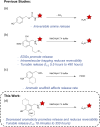Controlling rates and reversibilities of elimination reactions of hydroxybenzylammoniums by tuning dearomatization energies
- PMID: 38994402
- PMCID: PMC11234877
- DOI: 10.1039/d4sc02985b
Controlling rates and reversibilities of elimination reactions of hydroxybenzylammoniums by tuning dearomatization energies
Abstract
Hydroxybenzylammonium compounds can undergo a reversible 1,4- or 1,6-elimination to afford quinone methide intermediates after release of the amine. These molecules are useful for the reversible conjugation of payloads to amines. We hypothesized that aromaticity could be used to alter the rate of reversibility as a distinct thermodynamic driving force. We describe the use of density functional theory (DFT) calculations to determine the effect of aromaticity on the rate of release of the amine from hydroxybenzylammonium compounds. Namely, the aromatic scaffold affects the dearomatization reaction to reduce the kinetic barrier and prevent the reversibility of the amine elimination. We consequently synthesized a small library of polycyclic hydroxybenzylammoniums, which resulted in a range of release half-lives from 18 minutes to 350 hours. The novel mechanistic insight provided herein significantly expands the range of release rates amenable to hydroxybenzylammonium-containing compounds. This work provides another way to affect the rate of payload release in hydroxybenzylammoniums.
This journal is © The Royal Society of Chemistry.
Conflict of interest statement
The authors declare no conflict of interest.
Figures






Similar articles
-
Short-Term Memory Impairment.2024 Jun 8. In: StatPearls [Internet]. Treasure Island (FL): StatPearls Publishing; 2025 Jan–. 2024 Jun 8. In: StatPearls [Internet]. Treasure Island (FL): StatPearls Publishing; 2025 Jan–. PMID: 31424720 Free Books & Documents.
-
Sexual Harassment and Prevention Training.2024 Mar 29. In: StatPearls [Internet]. Treasure Island (FL): StatPearls Publishing; 2025 Jan–. 2024 Mar 29. In: StatPearls [Internet]. Treasure Island (FL): StatPearls Publishing; 2025 Jan–. PMID: 36508513 Free Books & Documents.
-
Interventions to reduce harm from continued tobacco use.Cochrane Database Syst Rev. 2016 Oct 13;10(10):CD005231. doi: 10.1002/14651858.CD005231.pub3. Cochrane Database Syst Rev. 2016. PMID: 27734465 Free PMC article.
-
Fabricating mice and dementia: opening up relations in multi-species research.In: Jenkins N, Jack-Waugh A, Ritchie L, editors. Multi-Species Dementia Studies. Bristol (UK): Bristol University Press; 2025 Feb 25. Chapter 2. In: Jenkins N, Jack-Waugh A, Ritchie L, editors. Multi-Species Dementia Studies. Bristol (UK): Bristol University Press; 2025 Feb 25. Chapter 2. PMID: 40690569 Free Books & Documents. Review.
-
Behavioral interventions to reduce risk for sexual transmission of HIV among men who have sex with men.Cochrane Database Syst Rev. 2008 Jul 16;(3):CD001230. doi: 10.1002/14651858.CD001230.pub2. Cochrane Database Syst Rev. 2008. PMID: 18646068
References
Grants and funding
LinkOut - more resources
Full Text Sources

